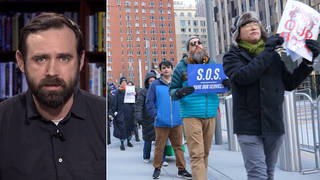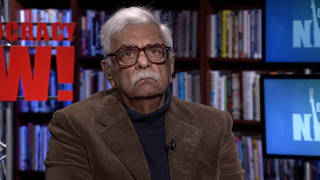
Related
Topics
Guests
- Gustavo Estevafounder of the Universidad de la Tierra in Oaxaca and author of many articles and books. Gustavo is an independent writer and grassroots activist and has been a columnist for La Jornada.
- Damian LopezOaxacan filmmaker and media activist with Mal de Ojo TV, a collective that came together during the 2006 popular uprising in Oaxaca. He was a collaborator on Compromiso Cumplido, or True to My Pledge, the first of a two-part documentary about human rights violations by the state during the current conflict in Oaxaca.
- Simon Sedilloactivist and filmmaker. He has been working in and out of Oaxaca for the last eight years documenting and teaching community based video documentation in indigenous communities. Simon collaborated with the Austin Independent Media Center on the 2005 production of El Enemigo Común which documents paramilitary activity in Oaxaca from 2001 through 2005. He maintains a blog at “Elenimogocmun” and is working on a new film project called El Machete, a Proyecto Autogestion documentary, filmed and edited by indigenous community members in Oaxaca.
Tensions remain high in Oaxaca, Mexico, more than a year after the state’s bloody crackdown on striking school teachers led to a popular uprising against Governor Ulises Ruiz. Last week Ruiz sent in hundreds of heavily armed state police to prevent a popular celebration from taking place. At least one person was killed with dozens more wounded and arrested. We go to Oaxaca to speak to veteran independent journalist, activist and intellectual Gustavo Esteva. We’re also joined by Oaxaca-based activist filmmakers Damian Lopez and Simon Sedillo. [includes rush transcript]
Transcript
AMY GOODMAN: Tensions are high in Oaxaca, Mexico — that’s where Oaxaca, the site of the tension, is — more than a year after the state’s bloody crackdown on striking school teachers led to a popular uprising against Governor Ulises Ruiz.
This week, the Oaxacan state began staging its official celebration [of Guelaguetza], the most important indigenous folk festival in Oaxaca. Since last year this festival has become a flashpoint of the struggle between popular movements and the state. Last month, the teacher’s union and APPO, the Popular Assembly of the People’s of Oaxaca, voted to reclaim the event from corporate and state control. They planned to hold a free celebration early last week as an alternative to the official Coca-Cola-sponsored event aimed at tourists.
Thousands of people marched down the streets last Monday demanding the resignation of the deeply unpopular state governor. Governor Ruiz is widely held responsible for leaving the violent deaths of some 25 protesters last year unpunished.
In response to last week’s gathering, the governor sent in hundreds of heavily armed state police to prevent the popular celebration from taking place. The police attacked the crowds, and reports indicate at least 70 people were arrested, forty were seriously wounded. Emeterio Cruz Vasquez, a 46-year-old plumber and spouse of a striking teacher, died from his wounds. Human Rights Watch urged Oaxacan state officials to investigate allegations of excessive police violence against the demonstrators.
Today we find out more about the popular struggles and demands in the embattled region of Oaxaca. We’ll be joined in the firehouse studio by Oaxaca-based activists and filmmakers Damian [Lopez] and Simon Sedillo, but first we turn to veteran independent journalist, activist and intellectual, Gustavo Esteva, who joins us on the phone from Oaxaca. He’s the founder of the University of the Earth in Oaxaca, Universidad de la Tierra, and has been a columnist for the Mexican newspaper La Jornada. Welcome to Democracy Now!, Gustavo Esteva.
GUSTAVO ESTEVA: Good morning. How are you?
AMY GOODMAN: Very good. Explain what is happening now in Oaxaca.
GUSTAVO ESTEVA: Well, basically, my feeling is that the mood of the people today is that we are hoping for the best, but we are preparing for the worst, because the last Monday the people gave magnificent, magnificent signs of courage and restraint, and at the same time we got signs of incompetence, irresponsibility and a very dangerous attitude in the state and the president government.
What we are seeing basically is that they have been training the police, both of the municipal, the state and the federal police, in an exercise of clear impunity. This was very clear, very open in the repression 15 days ago in July 16, when they were very vicious in the open repression of the people, even with journalists there, in front of journalists that were also beaten, and telling them, “You can do whatever you want. You can take photos. You can do whatever they want.”
And they have this feeling of impunity because they know very well — we all know — that, for example, the killers of Brad Will, those that we had in the video, are in their public offices. They are officers. There is not one single case of any police or any person even accused of doing anything against them, in spite of the fact that we have all kind of documentation proofs. The local organizations of human rights, the international organizations, we have all kind of elements.
The federal government are still saying that they will not intervene, that this is a local affair. But at the same time, it is only the federal government that can authorize the use of the army. And the army, in this occasion, last Monday, they stopped buses in the road, and they were in the hills where the events happened. Then the federal government is intervening, is still supporting this psychopathic governor and supporting this repression of the social movements. Apparently, they continue trying to give the lessons to the people of Oaxaca and to the people of the whole country that they are ready to pay the political price of this open violations of human rights, this obscene treatment of the social movements to keep the people in control.
AMY GOODMAN: Gustavo Esteva, with us in Oaxaca. We are also joined by two Oaxaca-based activist filmmakers, Damian [Lopez] and Simon Sedillo. Damian is a media activist, works with a collective that came together during the 2006 popular uprising in Oaxaca. He was a collaborator on Compromiso Cumplido, or True to My Pledge, the first of a two-part documentary about human rights violations by the state during the current conflict in Oaxaca. Simon Sedillo is an activist and filmmaker who’s been working in and out of Oaxaca for the last eight years, documenting and teaching community-based video to indigenous communities. We welcome you both to Democracy Now!
Why don’t we start off with Damian? Can you describe what your film collective is attempting to do right now? And I also want to alert our viewers and listeners, you can go to our website at democracynow.org to see some of the video of what’s taking place on the ground right now in Oaxaca. Damian? Simon, can you translate for Damian? Thank you.
DAMIAN LOPEZ: [translated] So my collective, Mal de Ojo TV, began since 14th of June, 2006, when Ulises began his repression against the popular movement. We began documenting this social uprising and social organizing around these issues and have been doing so since then.
AMY GOODMAN: And explain the name, Mal de Ojo.
DAMIAN LOPEZ: [translated] So, Mal de Ojo came out of a collective process. It’s Spanish for “the evil eye.” And we just collectively came together and came up with that name.
AMY GOODMAN: How hard is it to film in the streets?
DAMIAN LOPEZ: [translated] So, at first, it was obviously very difficult, and it’s always very difficult, but at first the people on the streets didn’t know the difference between necessarily independent media activists and regular media. So people had very little trust of mainstream media, because they had been kind of manipulating the story in the mainstream media. And then we also have the constant issue of deciding whether or not to use an independent media press badge, because it’s good to have that for the people to identify you as an independent journalist, but it’s bad for the police to identify you as an independent journalist.
AMY GOODMAN: And, Simon, you, yourself, are working on a film now that is edited by indigenous communities. Can you talk about the role of communities, the media in the communities? I mean, a community last year, APPO, taking over a radio station so they have some means to speak unfiltered to the people.
SIMON SEDILLO: Absolutely. I think, more than anything, it’s important to understand that it’s a very broad-based movement, not just the teachers movement, but indigenous movement, workers, students, housewives, a lot of different people involved. And everybody traditionally has noticed the manipulation of mass media in Mexico. It’s very blatant. It’s very easy to point out and recognize. So independent media and taking back the media was an integral component of the APPO’s uprising.
One of the most important tools that they utilized was radio. A radio station that was controlled by the Section 22 teachers movement was actually shut down by the police on June 14. Immediately, the APPO occupied the university radio station, Radio Universidad, and held it for the entirety of the popular uprising. They also occupied the state-run TV and radio station, Canal Nueve, and at one point had occupied 11 commercial radio stations, which little by little were returned. But all this became a very, very integral component to the entire uprising.
AMY GOODMAN: Gustavo Esteva, Brad Will, you mentioned the American journalist who was killed last year in Oaxaca as he was covering the conflict. Other Oaxacans were also killed, not as well known in this country. And this year, the person who was just killed now in this latest conflict.
GUSTAVO ESTEVA: Yeah, and in this specific case — well, in fact, as in most of the other 26 cases that we have documented and those that we cannot document because the people are intimidated to report the deaths, those disappeared — but the fact is that this last case, we have very, very serious, serious photos and a video showing very clearly that when the police got this guy, he was in perfect condition. He was walking, and he has not any sign of any kind of problem, meaning that it was not in a conflict, it was not in a battle, that he was not attacking the police. He was just captured, and then after capturing him they started beating him.
AMY GOODMAN: Gustavo Esteva, I want to end with a clip from the documentary Compromiso Cumplido, or True to My Pledge, just released. Damian [Lopez] worked on the production. This is an excerpt.
UNIDENTIFIED WOMAN: Everything started in these neighborhoods due to insecurity. People started setting up their barricades. One day my husband said, “We’re just sitting here resting, and these people are risking their lives and losing sleep in the barricades.” He said, “Why don’t you make a pot of coffee, and we’ll take it there.” On October 14, he said, “Why don’t you make an oatmeal atole with bread, and we’ll take it to our friends in the barricade?” When it was around 2:30, he said, “Well, let’s get going.” And I said, “Yes, let’s go.”
We were just turning here to go home, when suddenly we heard the sirens of an ambulance. He said, “Let’s go open a path for the ambulance to get through.” He went back to do it, and I just stood there. I saw a truck that had been parked for a while in front of a bar got ahead of the ambulance and went over to the barricade. I heard the shots while they were shouting, “Long live Ulises Ruiz!” They started firing. I went back to see what had happened, and they told me that my husband was wounded. I found him on the ground in the middle of the street, drowning in his own blood.
AMY GOODMAN: Excerpt of Compromiso Cumplido. You can go to maldeojotv.net.












Media Options